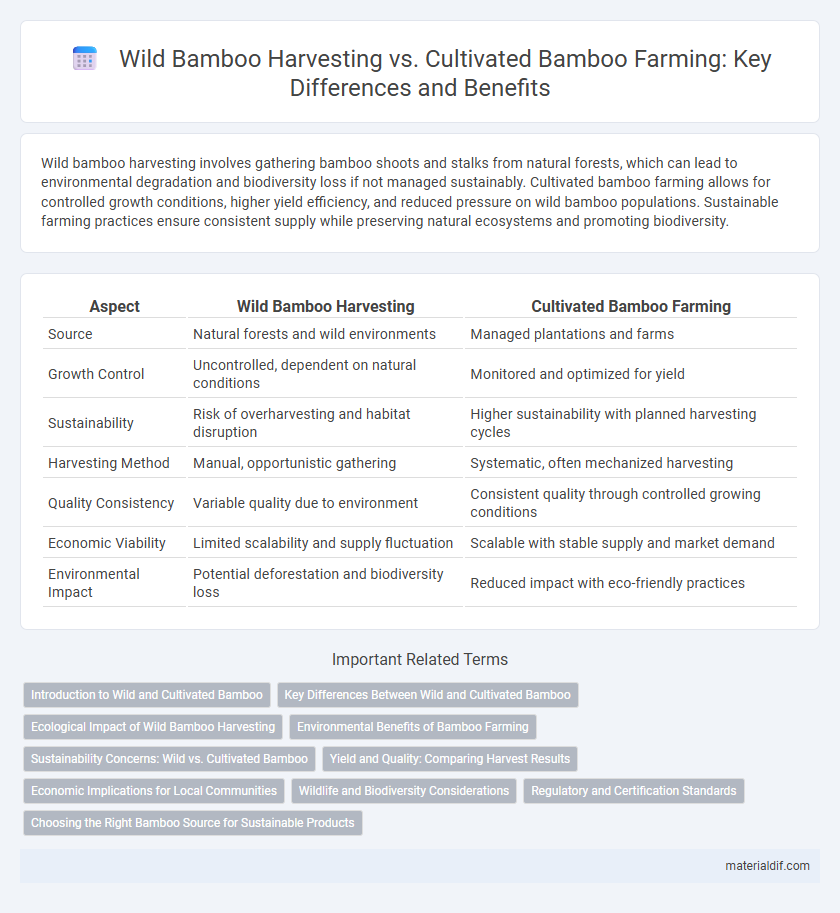Wild bamboo harvesting involves gathering bamboo shoots and stalks from natural forests, which can lead to environmental degradation and biodiversity loss if not managed sustainably. Cultivated bamboo farming allows for controlled growth conditions, higher yield efficiency, and reduced pressure on wild bamboo populations. Sustainable farming practices ensure consistent supply while preserving natural ecosystems and promoting biodiversity.
Table of Comparison
| Aspect | Wild Bamboo Harvesting | Cultivated Bamboo Farming |
|---|---|---|
| Source | Natural forests and wild environments | Managed plantations and farms |
| Growth Control | Uncontrolled, dependent on natural conditions | Monitored and optimized for yield |
| Sustainability | Risk of overharvesting and habitat disruption | Higher sustainability with planned harvesting cycles |
| Harvesting Method | Manual, opportunistic gathering | Systematic, often mechanized harvesting |
| Quality Consistency | Variable quality due to environment | Consistent quality through controlled growing conditions |
| Economic Viability | Limited scalability and supply fluctuation | Scalable with stable supply and market demand |
| Environmental Impact | Potential deforestation and biodiversity loss | Reduced impact with eco-friendly practices |
Introduction to Wild and Cultivated Bamboo
Wild bamboo harvesting involves collecting naturally growing bamboo from forests, offering diverse species and natural resilience but posing sustainability challenges. Cultivated bamboo farming ensures controlled growth, higher yields, and consistent quality through selective planting and management practices. Understanding the differences between wild and cultivated bamboo is essential for optimizing resource use and supporting environmental conservation.
Key Differences Between Wild and Cultivated Bamboo
Wild bamboo harvesting involves collecting naturally growing bamboo from forests, often leading to inconsistent quality and potential environmental degradation, while cultivated bamboo farming ensures controlled growth conditions, better quality, and sustainable yield. Wild bamboo typically exhibits a wider genetic diversity and irregular growth patterns, whereas cultivated bamboo is selectively bred for uniformity, faster growth, and specific industrial applications. The controlled environment in bamboo farming reduces pests and diseases, enhancing productivity compared to the unpredictability of wild bamboo ecosystems.
Ecological Impact of Wild Bamboo Harvesting
Wild bamboo harvesting leads to significant ecological disruption, including habitat loss for diverse wildlife and soil erosion due to unregulated cutting practices. Cultivated bamboo farming offers a sustainable alternative by promoting controlled growth cycles, enhancing carbon sequestration, and supporting biodiversity conservation. The ecological impact of wild bamboo harvesting underscores the necessity for sustainable management to preserve forest ecosystems and maintain soil stability.
Environmental Benefits of Bamboo Farming
Cultivated bamboo farming significantly enhances sustainability by enabling controlled harvesting cycles that prevent deforestation and soil erosion. Unlike wild bamboo harvesting, farming promotes biodiversity through managed ecosystems and reduces pressure on natural forests. Additionally, bamboo farms contribute to carbon sequestration, improving air quality and combating climate change.
Sustainability Concerns: Wild vs. Cultivated Bamboo
Wild bamboo harvesting often leads to habitat degradation and reduced biodiversity due to uncontrolled extraction, posing significant sustainability concerns. Cultivated bamboo farming promotes soil conservation, carbon sequestration, and controlled harvesting cycles, enhancing environmental sustainability. Sustainable bamboo management prioritizes responsible cultivation practices and regeneration to balance economic benefits with ecosystem health.
Yield and Quality: Comparing Harvest Results
Wild bamboo harvesting typically yields lower quantities with greater variability due to inconsistent growth conditions, while cultivated bamboo farming offers higher, more predictable yields through controlled environments and selective breeding. Quality in wild bamboo can vary significantly, often presenting irregular culm thickness and fiber strength, whereas cultivated bamboo is optimized for uniformity and superior material properties. Farmers using sustainable cultivation techniques achieve consistently enhanced yield and quality, supporting better market reliability and long-term resource management.
Economic Implications for Local Communities
Wild bamboo harvesting often provides immediate income opportunities for local communities through foraging and selling raw materials, but it can lead to resource depletion and inconsistent supply, harming long-term economic stability. Cultivated bamboo farming requires initial investments and labor but offers sustainable, predictable yields that support steady employment, value-added processing businesses, and improved local economies. Promoting cultivated bamboo farming can enhance economic resilience by fostering market development, environmental sustainability, and community empowerment in rural areas.
Wildlife and Biodiversity Considerations
Wild bamboo harvesting often disrupts local ecosystems by removing essential habitats and food sources for diverse wildlife species, leading to reduced biodiversity in those areas. In contrast, cultivated bamboo farming can be managed to support biodiversity by maintaining buffer zones, planting native species, and implementing sustainable harvesting practices that protect wildlife habitats. Sustainable bamboo cultivation promotes ecosystem stability and conserves flora and fauna, balancing economic benefits with environmental stewardship.
Regulatory and Certification Standards
Wild bamboo harvesting often involves stricter regulatory scrutiny due to environmental protection laws and conservation efforts to prevent habitat disruption. Cultivated bamboo farming benefits from established certification standards like FSC (Forest Stewardship Council) and organic certifications, ensuring sustainable management and traceability throughout the supply chain. Regulatory frameworks increasingly emphasize sustainable practices, promoting responsible bamboo sourcing to meet global demand while preserving biodiversity.
Choosing the Right Bamboo Source for Sustainable Products
Wild bamboo harvesting often involves extracting bamboo from natural forests, which can lead to habitat disruption and depletion of local biodiversity. Cultivated bamboo farming prioritizes controlled growth, ensuring consistent supply and minimizing environmental impact through sustainable agricultural practices. Selecting cultivated bamboo supports ecosystem balance and long-term resource availability, making it the preferred choice for eco-friendly product manufacturing.
Wild bamboo harvesting vs cultivated bamboo farming Infographic

 materialdif.com
materialdif.com